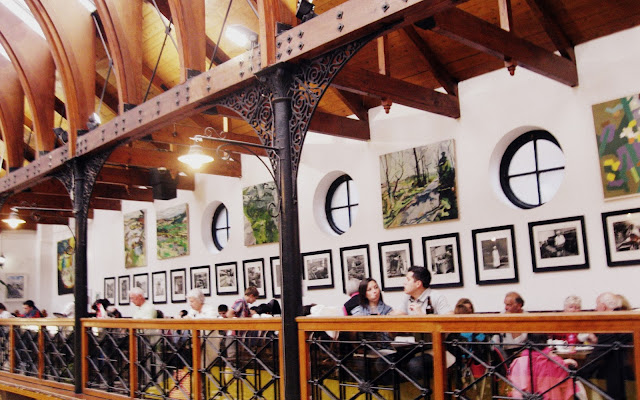 |
| Cork City Shopping |
Waking up at the Imperial Hotel in Cork City with no clothes wasn't the result of a torrid love affair. Rather, it was waking up to deal with the fact my clothes were gone because they'd been stolen (see Ireland Part One). Regardless of our predicament, The Imperial Hotel is beautiful and historic, in fact, Charles Dickens had once been a guest. It's outfitted in dark wood, marble, and fresh flowers. Regretfully, I didn't photograph it, but I was trying to conserve my camera battery until I could get a replacement charger.
In Drogheda, I had managed to buy some knickers and toiletries, but still needed some clothes to see me through the rest of the trip. The woman managing the front desk at The Imperial kindly recommended a store called Penneys which carries inexpensive knock-offs of current fashions. It was near the hotel, so I went there directly and spent the next hour trying to figure out European sizes and squeezing myself into the trendy "super skinny jeans" which were the only jeans available at Penny's. I had never before dared to put on a skinny jean, but I was cornered. Much to my surprise, I liked the tight, stretchy Mick Jagger pants and bought four pairs in different colors. I owe a huge debt to the thieves who took away my tired boot leg jeans and forced me, legs first, into becoming a nouveau hipster.
Enough about skinny jeans, Cork City is actually about food. It is in fact, the culinary mecca of Ireland. The famous English Market is nestled in the heart of the downtown, and houses vendors selling seafood, produce, meat, poultry, spices, baked goods, and chocolates. It reminds me of The Pike Place Market in Seattle, one of my other favorite places on Earth. The name, English Market, seems odd in Ireland, but it goes back to the earlier history of the city. It was established in 1788 as the Grand Parade market by a Protestant (English) corporation that controlled commerce in the city. At that time, Catholics were not allowed to be vendors at the Grand Parade. In response, Catholic vendors established their own market in the city, named St. Peter's Market. Eventually, the two markets came to be known simply as The English Market and The Irish Market. In the long run, only The English Market survived. However, by the time the Irish Market closed, Catholics had gained full membership to The English Market. It still stands today as a home to all the regionally procured treasures that make Ireland special to food lovers.
The market is also home to the esteemed Farmgate Café. The cafe is on the second floor of the market with a layout allowing diners to look down on all the goings-on of the market as they savor their meals. Farmgate is revered for their take on simple, traditional Irish food prepared from locally sourced ingredients. Lucy and I had lunch there, and we could have ordered anything off the chalkboard menu and been outrageously pleased. We both ended up choosing the Irish Lamb Stew. I wanted something classic and the fact that it was another chilly, rainy day beckoned for comfort food. The stew came with a wonderful heaping of Irish mashers to go with.
I can't write about Cork and not mention Darina Allen, one of Ireland's most famous chefs. Darina has been referred to as the "Julia Child of Ireland" and that's probably because she is a pioneer in teaching other people to cook simple, traditional dishes using fresh local ingredients, not just in the Irish tradition, but with an emphasis on world cuisine. She has her own cooking shows and is a renowned cookbook author. In 1983, she and her husband started the Ballymaloe Cookery School, which is located in County Cork. The school has become one of the most famous cooking schools in Europe. As if that weren't enough, Darina also founded the first farmer's market in Ireland. A few years ago, I bought her cooking compendium, Forgotten Skills of Cooking, and it's become one of my all time favorite cookbooks. Thanks to Darina, I finally learned the art of making a French Omelette. If you love food and care about local food movements, then Darina Allen should be one of your heros.
After Lucy and I enjoyed our comfort food, we went back to the hotel and begged the porter to draw us a map, illustrating the way out of Cork City. We wanted an air-tight plan since getting to the hotel the night before nearly broke us emotionally, at least I was nearly broken. The map did work. This time we only made one wrong turn instead of several and soon we were on the N22 roller coaster towards Killarney. I say roller coaster because this portion of the journey was our introduction to the more narrow, incredibly curvy roads of Ireland. There had been steady, hard rains for the past couple days in Ireland causing flash floods so it was another white knuckle drive as I gripped the dashboard or anything else I could clench with my hands, listening to the side mirrors tap other cars. Aside from the road warrior anxiety, crossing from Cork City to Killarney was a game changer for other reasons. Ireland was already magical, but the magic takes on a whole new meaning in the western half.
 |
| A porter's hand drawn map. |







No comments:
Post a Comment